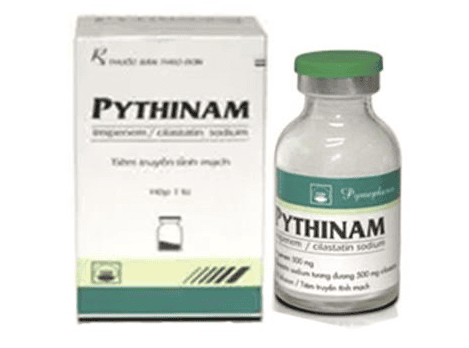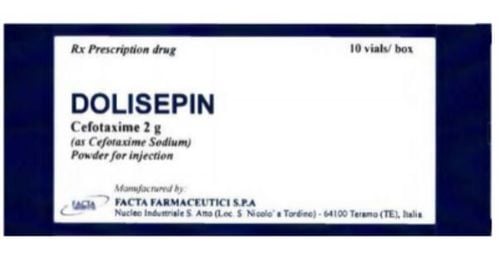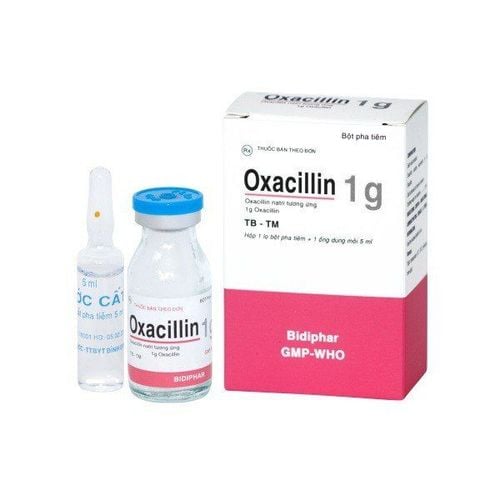This is an automatically translated article.
Greenkaxone is an antibiotic used by injection, indicated in cases of susceptible bacterial infections. This is an antibiotic, so it should only be used when there is an infection and oral antibiotics are not effective.
1. What are the uses of Greenkaxone?
Greenkaxone drug has the main ingredient is Ceftriaxone sodium 1.19mg (equivalent to 1g Ceftriaxon) in the form of powder and solvent for injection is 1 ampoule of 10ml distilled water.
Ceftriaxone is a broad-spectrum 3rd generation Cephalosporin antibiotic, because it is almost not absorbed when taken orally, so it is used only as an injection. The bactericidal effect of cephalosporin antibiotics is due to inhibition of bacterial cell wall synthesis. Ceftriaxone is stable to most beta lactamases (Penicilinase and Cephalosporinase) of Gram-negative and Gram-positive bacteria. Ceftriaxone antibiotics are usually effective in clinical infections with the following bacteria:
Gram-negative aerobic: Acinetobacter calcoaceticus, Enterobacler aerogenes, Enterobacter cloacae, Escherichia coli, Haemophilus influenzae (including ampicillin-resistant strains), Haemophilus parainfluenzae, Klebsiella oxytoca, Klebsiella pneumoniae, Morganella morganii, Neisseria gonorrhoeae, Neisseria meningitidis, Proteus mirabilis, Proteus vulgaris, Serratia marcescens. Ceftriaxone is also active against many strains of Pseudomonas aeruginosa. Gram-positive aerobic: Staphylococcus aureus (including Penicilinase-producing strains), Staphylococcus epidermidis, Streptococcus pneumoniae, Streptococcus pyogenes, Streptococcus viridans Anaerobic bacteria: Bacteroides fragilis, Clostridium species, Peptostreptococcus Gram-negative aerobic species: Citrobacter diversus, Citrobacter freundii, Providencia species (including Providencia rettgeri) Salmonella (including S. typhi), Shigella species.
2. Indications and contraindications of the drug Greenkaxone
Greenkaxone is used to kill bacteria, so it is indicated in case of infection with sensitive bacteria, including:
Lower respiratory tract infections caused by bacteria such as Streptococcus pneumoniae. Streptococcus, Staphylococcus aureus, Haemophilus influenzae, Haemophilus parainfluenzae, Klebsiella species (including Klebsiella pneumoniae), Escherichia coli, Enterobacter aerogenes, Proteus mirabilis. Skin infections caused by Staphylococcus aureus, Staphylococcus epidermidis, Streptococcus species, Enterobacter cloacae, Klebsiella species (including Klebsiella pneumoniae), Proteus mirabilis, Pseudomonas aeruginosa. Urinary tract infections (complicated and uncomplicated): Caused by Escherichia coli, Proteus mirabilis, Proteus vulgaris, Proteus morganii or Klebsiella species. Uncomplicated gonorrhea: Caused by Neisseria gonorrhoeae, even when the bacteria are already resistant to penicillin. Pelvic inflammatory disease caused by Neisseria gonorrhoeae. Bacteremia caused by bacteria such as: Staphylococcus aureus, Streptococcus pneumoniae, Escherichia coli, Haemophilus influenzae, Klebsiella pneumoniae. Bone and joint infections caused by susceptible bacteria such as Staphylococcus aureus, Streptococcus pneumoniae, Streptococcus species, Escheria coli, Proteus mirabilis, Klebsiella pneumoniae or Enterobacter species; Intra-abdominal infections caused by Escherichia coli, Klebsiella pneumoniae. Meningitis caused by Haemophilus influenzae. Neisseria meningitidis, Streptococcus pneumoniae. Staphylococcus epidermidis and Escherichia coli. Greenkaxone should not be used in the following cases:
Patients who are allergic to Cephalosporin antibiotics; Premature infants not treated with Ceftriaxon; Newborns with hyperbilirubinemia.
3. Dosage and how to use Greenkaxone
3.1. How to use Greenkaxone The drug can be used in different ways:
Intramuscular solution: Dissolve 1g of Greenkaxone in 3.5 ml of 1% lidocaine solution, then proceed to intramuscular injection. Do not inject more than 1g at the same site. Do not use solutions containing lidocaine for intravenous administration. Intravenous solution: Dissolve lg Greenkaxone in 10ml of distilled water for injection. Intravenous injection time is 2-4 minutes. Inject directly into a vein or can be through a solution infusion line, but the wire should be thoroughly rinsed before injection. Solution for infusion: Infusion when the drug content is greater than 1g. Dissolve 2 g of powder in 40ml of calcium-free infusion solution such as sodium chloride 0.9%; glucose 5%, 10% or a solution containing sodium chloride and glucose (0.45% sodium chloride and 2.5% glucose). Do not use Ringer lactate solution to dissolve the drug for infusion. The infusion time is at least 30 to 60 minutes. 3.2. Dosage of Greenkaxone Adult: The usual daily dose is from l to 2g, injected once (or can be divided equally into 2 times). In severe cases, up to 4g per day can be used. Specifically:
To prevent infection during surgery, a single dose of 1g intravenously from 0.5 to 2 hours before surgery. For the treatment of uncomplicated gonorrhea, a single dose of 250 mg intramuscularly is used. Children: The daily dose is 50 - 75mg/kg, divided equally into 2 times 12 hours apart. The total dose should not exceed 2g per day. Doses greater than 50 mg/kg should be administered intravenously over 60 minutes only. Specifically:
In the treatment of meningitis: The starting dose is 100mg/kg (not more than 4g). Then the total daily dose is 100mg/kg/day, injected once a day. The duration of treatment is usually 7 to 14 days. Neonates: up to 50mg/kg/day, intravenous infusion over 60 minutes. Patients with renal impairment:
When the creatinine clearance is less than 10ml/min, the dose of Ceftriaxone should not exceed 2g/24 hours. For patients on hemodialysis, a 2g dose administered at the end of dialysis is sufficient to maintain effective drug concentrations until the following dialysis session, usually within 72 hours.
4. Undesirable effects of the drug Greenkaxone
In general, the antibiotic Ceftriaxone is well tolerated. About 8% of patients treated with this drug have side effects, the frequency of which depends on the dose and duration of treatment.
Side effects include:
Common: Diarrhea, skin reactions, itching, rash; Uncommon: Fever, phlebitis, edema, eosinophilia, thrombocytopenia, leukopenia, urticaria. Rare: Headache, dizziness, anaphylaxis, anemia, agranulocytosis, coagulation dysfunction, pseudomembranous colitis, erythema multiforme, hematuria, increased serum creatinine, increased transient liver enzymes during treatment with ceftriaxone. Other reactions: Long-term use of high doses can be seen on ultrasound images of gallbladder sludge or pseudo-gallstones due to calcium salt deposition of Ceftriaxone. This image will disappear when the drug is stopped. When using the drug, if you find any abnormality, you need to inform your doctor immediately.
5. Notes when using the drug Greenkaxone
Like other antibiotics, when using Greenkaxone, it also causes the growth of bacteria, fungi or other pathogenic microorganisms. Antibiotic-associated pseudomembranous colitis is usually caused by Clostridium difficile and should be considered if diarrhea persists. Ceftriaxone can cause separation of bilirubin from serum albumin, increasing the concentration of free bilirubin, threatening CNS toxicity. Therefore, this drug should be avoided in neonates with jaundice, especially premature infants. A positive Coombs reaction without hemolysis, a blood galactose test, and a false positive urine glucose test may occur with Ceftriaxone. No dose adjustment is required for patients with hepatic dysfunction and renal impairment. However, no more than 2g per day should be taken without close monitoring of plasma concentrations. Use Greenkaxone with caution in patients with a history of gastrointestinal disease, especially those with inflammatory bowel disease. Pregnancy: There are no adequate studies on the use of Ceftriaxone in pregnant women. Therefore, this drug should be used only when absolutely necessary. Lactation: The drug is excreted in milk in low concentrations. Caution should be exercised when using Greenkaxone in nursing women. Drug Interactions: The nephrotoxic potential of Cephalosporins may be increased by drugs such as Gentamicin, Colistin, Furosemide. Probenecid increases plasma concentrations of the drug due to a decrease in renal clearance. Ceftriaxone antibiotic should not be mixed with other antibacterial drug solutions. Ceftriaxone must not be mixed with solutions containing calcium and aminoglycosides, Amsacrin, antibiotics Vancomycin or Fluconazole because precipitation may occur. The article has provided information about Greenkaxone drug, this is an intravenous antibiotic, so it is used only in cases that do not respond to conventional antibiotics. If there is any abnormality while taking the drug, consult your doctor and pharmacist.
Please dial HOTLINE for more information or register for an appointment HERE. Download MyVinmec app to make appointments faster and to manage your bookings easily.













